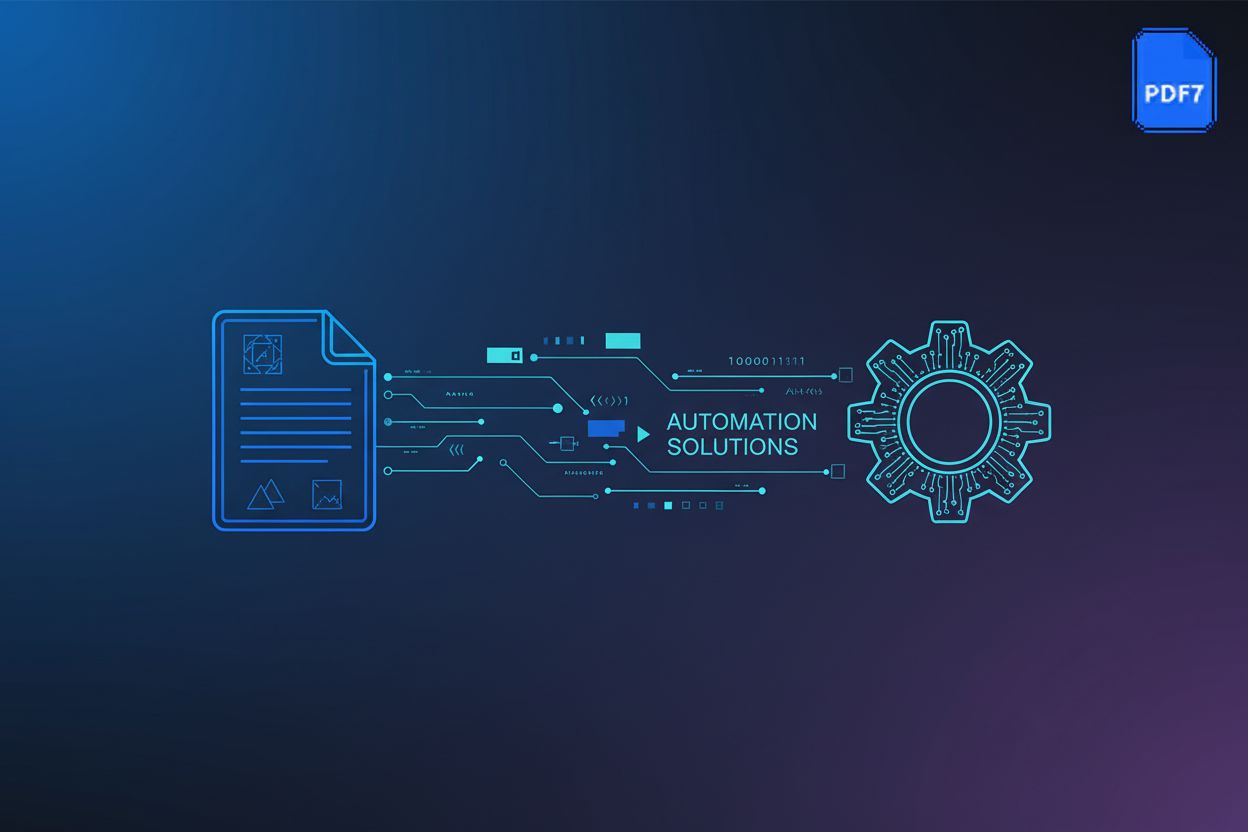Automated PDF Tagging for Accessibility (WCAG/Section 508)
Introduction to PDF Accessibility and Tagging
Imagine navigating a website where every image is a mystery, every form field a guessing game. PDF accessibility ensures everyone, regardless of disability, can access digital content. Let's dive into how PDF tagging makes this possible.
PDF accessibility means designing Portable Document Format (PDF) files so they are usable by people with disabilities. This involves making PDFs compatible with assistive technologies like screen readers.
- WCAG Compliance: Adhering to the Web Content Accessibility Guidelines (WCAG) 2.0 is crucial. WCAG provides a set of guidelines to make web content more accessible to a wider range of people with disabilities. We're focusing on WCAG 2.0 here as it's still widely referenced and a foundational standard, though newer versions exist.
- Section 508 Standards: In the U.S., Section 508 of the Rehabilitation Act mandates that federal agencies' electronic and information technology is accessible to people with disabilities. This is a key regulation for government entities.
- PDF/UA Compliance: PDF/UA, or ISO 14289, is an international standard for accessible PDF documents, ensuring compatibility with assistive technologies.
Tagging adds a hidden layer of structure to a PDF, similar to how HTML tags structure a webpage. These tags provide semantic meaning, allowing assistive technologies to understand the content's organization and present it to users effectively.
- Semantic Structure: Tags define headings, paragraphs, lists, tables, and images, creating a logical reading order.
- Alternative Text: Tags allow adding alternative text to images, so screen readers can describe the image content to visually impaired users.
- Form Field Labels: Tagging form fields with descriptive labels makes them understandable and usable by everyone.
Accessible PDFs are not just a matter of compliance but also of inclusivity.
- Legal Requirements: Many organizations are legally required to make their digital content accessible.
- Wider Audience Reach: Accessibility expands your potential audience by including people with disabilities.
- Improved Usability: Accessible documents are often more usable for everyone, including those without disabilities.
Consider a financial report distributed as a PDF. By properly tagging the document, a screen reader can announce headings, read paragraphs in the correct order, and describe charts and graphs using alternative text. This enables a blind investor to understand the report as effectively as a sighted one.
Understanding the basics of PDF accessibility and tagging sets the stage for exploring the challenges of manual tagging, which we'll cover in the next section.
Challenges of Manual PDF Tagging
Did you know that tagging a single PDF document manually can take hours, even for experienced professionals? (Creating accessible PDFs in Adobe Acrobat) This painstaking process highlights the challenges many organizations face in making their digital content accessible.
Manual PDF tagging is notoriously time-consuming. Each element within a document—headings, paragraphs, images, tables—must be individually tagged to ensure screen readers can interpret the content correctly.
- For instance, a 100-page financial report could require dozens of hours to tag comprehensively. ([PDF] 2024 Annual report - Banco Santander)
- This is especially true for complex layouts with multiple columns, embedded graphics, and intricate tables.
Human error is a significant concern in manual tagging. The process requires meticulous attention to detail, and even minor mistakes can render a document inaccessible.
- Mislabeling a heading or failing to provide alternative text for an image can lead to a frustrating experience for users relying on assistive technologies.
- Ensuring consistent application of tagging standards across large volumes of documents is difficult.
PDF accessibility isn't just about adding tags; it requires a deep understanding of accessibility standards like Web Content Accessibility Guidelines (WCAG) 2.0 and Section 508, as mentioned earlier.
- Tagging specialists need to know how to properly structure content, provide meaningful alternative text, and ensure logical reading order.
- Training and retaining skilled accessibility professionals can be costly for organizations.
As organizations create more digital content, manual tagging becomes increasingly difficult to scale. The labor-intensive nature of the process makes it challenging to keep up with the demand for accessible documents.
- Government agencies and large corporations often have massive archives of PDFs that need to be made accessible to comply with regulations like Section 508.
- Manually tagging these documents would require significant resources and time.
The combined effect of these challenges—time, errors, expertise, and scalability—results in significant cost implications. Organizations must invest in training, dedicate staff time, and potentially face legal consequences for non-compliance.
- Outsourcing PDF tagging to specialized firms can be expensive, especially for large volumes of documents.
- Remediation costs can quickly escalate if accessibility issues are not addressed early in the document creation process.
Overcoming these hurdles is essential for creating truly inclusive digital experiences, which leads us to the rise of automated PDF tagging solutions.
The Rise of Automated PDF Tagging
Did you know that automated PDF tagging can reduce accessibility remediation costs by up to 80%? (Solving PDF Accessibility Challenges with Smart PDF Remediation) As organizations grapple with the increasing demand for accessible digital content, automated PDF tagging has emerged as a game-changing solution.
Automated PDF tagging tools use artificial intelligence (ai) and machine learning (ml) to analyze and tag PDF documents. This significantly reduces the time and resources required compared to manual tagging.
- Speed and Scalability: Automated tools can process hundreds or even thousands of pages in a fraction of the time it would take a human, making it easier to scale accessibility efforts across large document repositories.
- Reduced Error Rate: Ai-driven tagging minimizes human error, ensuring greater consistency and accuracy in applying accessibility standards.
- Cost Savings: By reducing the need for manual labor, organizations can achieve substantial cost savings in PDF accessibility remediation.
These tools employ sophisticated algorithms to identify and classify different elements within a PDF. They then apply appropriate tags based on predefined rules and accessibility standards.
- Content Recognition: Ai algorithms analyze text, images, tables, and other content to determine their semantic meaning and structure.
- Tagging Application: Once the content is recognized, the tool automatically applies the appropriate tags, such as headings, paragraphs, lists, and alternative text for images.
- Compliance Checks: Many tools also include built-in accessibility checkers that verify compliance with standards like Web Content Accessibility Guidelines (WCAG) 2.0 and Section 508, as previously discussed.
Automated PDF tagging is transforming how various sectors approach document accessibility. These solutions are not one-size-fits-all, but instead, they can be applied across a broad range of industries.
- Financial Services: Banks and investment firms use automated tools to make financial reports, statements, and disclosures accessible to all clients. This ensures compliance with accessibility regulations and promotes inclusivity.
- Education: Universities and schools leverage automation to tag course materials, research papers, and other documents, providing equal access to students with disabilities.
- Government: Federal, state, and local agencies rely on automation to ensure that public-facing documents meet Section 508 requirements.
Imagine a large healthcare organization with thousands of patient records stored as PDFs. By implementing an automated PDF tagging solution, the organization can quickly make these records accessible, ensuring that patients with visual impairments can easily access their medical information.
As automation continues to advance, it's essential to understand the key features of these tools to maximize their effectiveness, which we'll explore in the next section.
Key Features of Automated PDF Tagging Tools
Did you know that some automated PDF tagging tools can identify and tag over 99% of document elements correctly? These tools come packed with features designed to streamline accessibility compliance. Let's explore some of the most important ones.
Content Recognition and Classification: At the heart of automated tagging lies sophisticated Optical Character Recognition (OCR) and ai-powered content analysis. These tools can accurately identify headings, paragraphs, lists, tables, images, and form fields within a PDF.
- For example, a tool might recognize a specific font and size as a heading level 1, or identify a table structure based on the arrangement of cells.
- This feature significantly reduces the manual effort involved in identifying and classifying document elements.
Automated Tagging and Remediation: Once content is recognized, automated tools apply appropriate tags based on accessibility standards like Web Content Accessibility Guidelines (WCAG) 2.0, as mentioned earlier.
- The tools can automatically add alternative text to images, label form fields, and ensure a logical reading order.
- Some tools also offer automated remediation, fixing common accessibility issues like missing tags or incorrect heading levels.
Compliance Checking and Reporting: Many automated PDF tagging tools include built-in accessibility checkers that verify compliance with standards like Section 508, as previously discussed.
- These checkers generate detailed reports highlighting any remaining accessibility issues, providing actionable insights for further remediation.
- This feature helps organizations proactively identify and address accessibility gaps before publishing their documents.
Imagine a retail company that needs to make its product catalogs accessible. Using an automated PDF tagging tool, the company can quickly tag the catalog, ensuring that screen reader users can access product descriptions, prices, and other important information. This opens up the company's product line to a broader customer base.
These features not only save time and resources but also ensure greater consistency and accuracy in PDF accessibility. Understanding these key features sets the stage for exploring how to implement automated PDF tagging in practice.
Implementing Automated PDF Tagging: A Step-by-Step Guide
Ready to make your PDFs accessible? Implementing automated PDF tagging doesn't have to be daunting; here's a step-by-step guide to get you started.
Before diving in, it's crucial to assess your organization's specific needs and goals. What types of documents need to be made accessible? What compliance standards are you aiming to meet, such as Web Content Accessibility Guidelines (WCAG) 2.0 or Section 508, as referenced earlier?
- Identify the volume and complexity of PDFs that need tagging.
- Define the target accessibility standard (e.g., WCAG 2.0 Level AA).
- Determine the roles and responsibilities of team members involved in the process.
Choosing the right automated PDF tagging tool is essential for success. Look for tools that offer:
- Accurate content recognition: The tool should effectively identify and classify various document elements.
- Customizable tagging rules: You should be able to adjust the tool's settings to meet your specific accessibility requirements.
- Compliance checking: The tool should include built-in accessibility checkers to verify compliance with relevant standards.
Once you've selected a tool, configure it to align with your organization's needs. This involves:
- Setting default tagging rules: Define how different document elements should be tagged.
- Configuring alternative text settings: Establish guidelines for generating and applying alternative text to images.
- Customizing compliance checks: Select the specific accessibility standards you want the tool to check against.
With the tool configured, you can begin processing your PDF documents.
- Upload the PDF to the automated tagging tool.
- Initiate the tagging process, allowing the tool to analyze the document and apply tags automatically.
- Review the results and make any necessary manual adjustments.
Even with automated tools, human review is essential to ensure accuracy and completeness.
- Use the tool's accessibility checker to identify any remaining issues.
- Manually inspect the tagged document to verify the logical reading order and the accuracy of alternative text.
- Address any identified issues using the tool's remediation features or manual editing.
According to Create and verify PDF accessibility (Acrobat Pro), Acrobat Pro provides tools to check and make a PDF accessible and prompts you to address accessibility issues. This means that even if you use automated tools, having software like Acrobat Pro handy for final checks and minor tweaks is a good idea.
Transitioning to accessible PDFs is an ongoing process, which we'll cover in the next section.
Best Practices for Maintaining Accessible PDFs
Did you know that accessible PDFs require ongoing maintenance to remain compliant with evolving standards? Ensuring your PDFs stay accessible involves consistent effort and vigilance.
Conduct regular accessibility audits using automated tools and manual reviews. As mentioned earlier, tools like Acrobat Pro can help identify and address accessibility issues.
Engage users with disabilities in usability testing to gain valuable feedback. Real user testing can reveal issues that automated tests might miss.
When updating content, ensure all new elements are properly tagged. New images need alt text, and new sections need appropriate headings.
Periodically re-tag existing PDFs to align with the latest accessibility guidelines. Standards like Web Content Accessibility Guidelines (WCAG) 2.0 evolve, so staying current is crucial.
Provide ongoing training for content creators on accessibility best practices. Ensure staff understands how to create and maintain accessible documents.
Maintain clear documentation of your organization's accessibility standards and procedures. Standardized processes help ensure consistency.
Keep your PDF creation and tagging software up to date. Newer versions often include improved accessibility features and bug fixes.
Ensure that assistive technologies used for testing are also up to date. Compatibility issues can arise if your testing tools are outdated.
Imagine a financial institution that regularly publishes quarterly reports as PDFs. Each quarter, the reports are audited for accessibility, and any issues are addressed before publication. The institution also provides training to its staff on creating accessible charts and graphs.
Maintaining accessible PDFs is an ongoing commitment. The field of automated PDF accessibility is constantly evolving, with advancements in ai and ml promising even more sophisticated and efficient solutions in the future. Staying informed about these developments will be key to maintaining top-notch accessibility.





